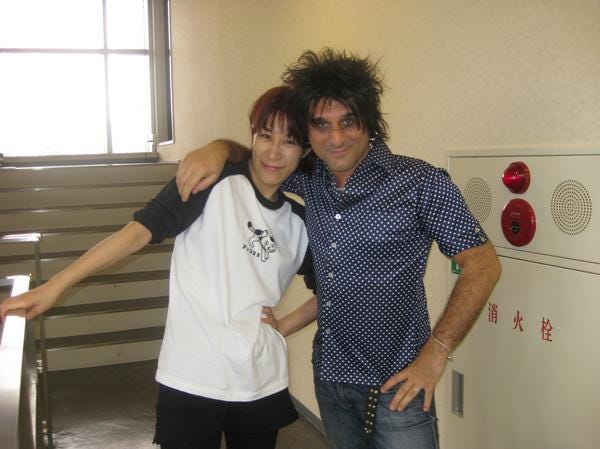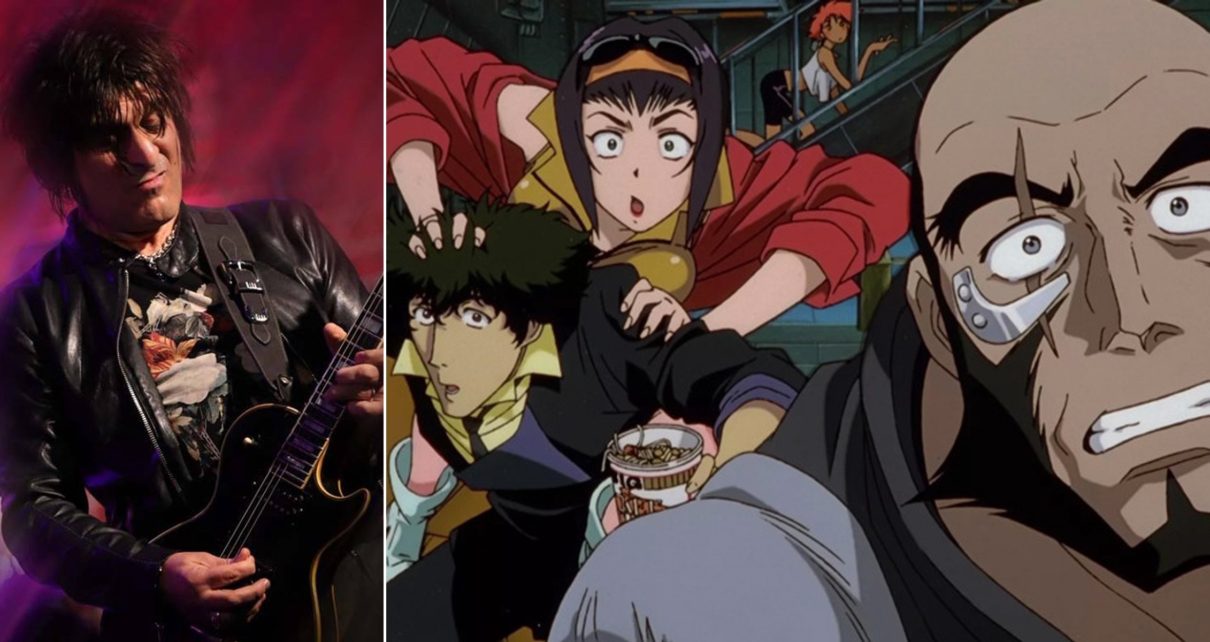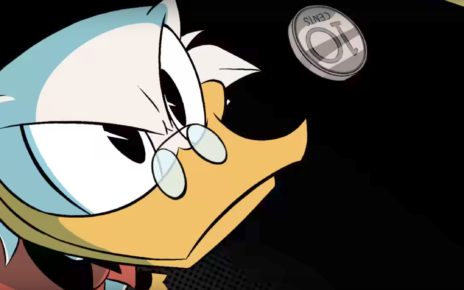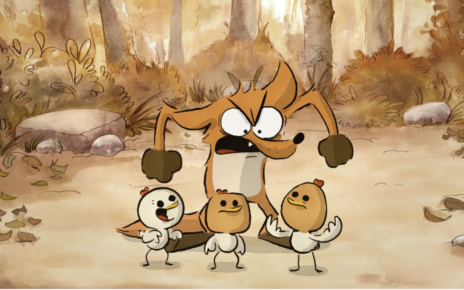Grace Notes

For one month, The Dot and Line is publishing essays, interviews, and discussions about each episode of Cowboy Bebop, which turns 20 this April.
If you’ve watched Cowboy Bebop, you’ve heard Steve Conte’s croon before. He was series composer Yoko Kanno’s pick to provide the English male vocals throughout the entirety of the series when the soundtrack was recorded in 1998. He’s also a touring and session musician based in New York City, known for his guitar work with The New York Dolls, the singer Michael Monroe (of Hanoi Rocks fame), and several other rock acts. When The Dot and Line caught up with Conte in April, he had just come off a night of playing at The Iridium Jazz Club in New York the night before, and proceeded to talk with us for an hour about what it was like to work with Kanno in the late ’90s on the Cowboy Bebop, Wolf’s Rain, and Ghost in the Shell soundtracks—as well as his impressions of the show and anime fandom in general these days. We’ve broken out a few of the best excerpts from the long, sprawling conversation below.
Conte’s interview responses have been condensed for length and clarity. You can follow Conte on Facebook as well as Twitter, and check out his website at stevecontenyc.com.
“Hey, I’ve got a New York guy….”
Steve Conte has lived in New York playing gigs for plenty of bands, including the New York Dolls, and now for the singer Michael Monroe. He’s also a solo musician.
I’m a New York City musician. I’ve played here for 30 years or so. It’a smorgasbord of musical opportunity for me ‘cause I’ve been around so long here, and I know so many people, and I’m always going out on the road, meeting other people. You run into all these other musicians in, y’know, Finland, or summer touring in Brussels and Europe, you run into people that you never see in New York and you have a kind of bond like, “Hey, I’ve got a New York guy.” But my main like pay-the-rent gig right now, money making gig is, I play with a guy called Michael Monroe from the band Hanoi Rocks. [They] came out like early 1980s. They were probably the band that influenced Guns ‘n’ Roses the most.
“Oh yeah, call on Steve Conte.”
His reputation as New York session and touring musician is how he was first enlisted by Yoko Kanno in the ‘90s.
I grew up sorta looking at [New York] and all the musicians in it going, “Wow if I could ever do that someday.” And then I got here and started small, doing a little session work, people’s demos in their home studios and stuff. And the circles widen. You start in the small circle and then if I’m being out and about and playing with different people, you meet this one and that one, and your name gets passed around, and the sessions start getting better. And that’s sort of what happened with Yoko.
I knew a drummer who I actually shared a rehearsal studio with in the building I have my current studio in, and we never even actually played together, I don’t think, but we knew each other. I may have given him a copy of one of my CDs or something. Either he had done something with Yoko, or his wife had, or he had some kind of connection, and he got the call from a Japanese woman who was Yoko’s go-between here and New York, because Yoko doesn’t speak such good English. So this woman apparently had called him up and said, “I need a rock singer for a Japanese artist who’s coming to New York to work on her solo album, can you recommend me someone?” And this guy said, “Oh yeah, call on Steve Conte.”
So I get the call, and I knew nothing about Yoko. She hadn’t even done any of the anime stuff yet, she was just a Japanese artist who was doing a solo record, and they said, “Can you send a tape?” These were still the days of cassette tapes I guess, or maybe it was a CD, and I made up something and sent it over, and they heard it, liked it, called me into the studio, and I went in and I sang, it was a song called “Everywhere and Nowhere.” It’s from her solo album called Song to Fly. And that was the first thing I did with her. I guess that was probably early 1998.

“I guess [Yoko Kanno] liked what I did…”
Then came calls for the show ‘Brain Powerd’…
I guess she liked what I did. I don’t remember if it was the same trip or if it was another trip, I did another song for her in an anime called, Brain Powerd. So I did a song, it might’ve been the same trip, might’ve been like the next day when she got the idea, “Oh I like what he sang, let me use him on this.” And I did that, it was called, “True Love Song” It was kind of a weird song. A weird song for someone to think of me to sing. But I’m pretty versatile. I’ve worked with people from Paul Simon to The New York Dolls, so I can kind of do anything in between there too.
“Had it been some other composer or some other singer, the look of ‘Cowboy Bebop’ might have been completely different.”
…and ‘Cowboy Bebop’—which was animated to Kanno’s music
I did that and then probably six months later or something she came back and she said, “There’s this new series that they’re making, called Cowboy Bebop, and what they’re gonna do is they’re gonna do the animation to our music,” instead of the other way around, like a lot of anime or cartoons or movies in general. They make the film and then they get a composer later to look at the film and score the film to what’s already been made, the visuals that are already there. But this was gonna be done the opposite way. They’re gonna be inspired by the way the music sounded to create the visuals.
When I think of it that way, I think, had it been some other composer or some other singer, the look of Cowboy Bebop might have been completely different. So in a way I feel like maybe we were an integral part of that whole thing. At least the songs that I’m most involved in.
“So she’s got this classical ensemble, like 30-piece string orchestra, and she wants me to sing live…”
Conte’s vocals appear on five songs on the soundtrack: “Rain,” “Call Me Call Me,” “Diggin,” “No Reply,” and “Words That We Couldn’t Say.”
The first thing I did with her was, for Cowboy Bebop, was, “Rain.” There had been a female version first, apparently, in another episode with Mai Yamane, and [Yoko] wanted a male version, so I did that. And then the next time she came, I think this was all in the same year, so she came back and forth a lot, or else we did them all in the same trip. “Rain” was on the first soundtrack, and “Call Me Call Me” was on Blue, which is the second one.
When she called me for “Call Me,” it was going to be the first time I’d ever done something like this. She wanted me to sing live with a 30-piece orchestra. And, whew, nerve-racking because you’re in an expensive studio, a studio called The Power Station, in New York, a really expensive studio. Studio time, you know, costs a lot, and engineers and musicians. So she’s got this classical ensemble, like 30-piece string orchestra, and she wants me to sing live, and we’re recording to tape. This is like before ProTools and when everybody had a laptop they were recording on. Proper old school recording. And I had learned the song, and it was a crazy way to work. These days, you can just go in, you and an engineer, and sit pretty much in a closet and do 10 different takes of the song and then say goodbye and they mix it all together later, and there’s the record. But this was live. So it was pretty exhilarating to hear those live strings, y’know, 30-piece orchestra going when you’re recording. So that came out great. And she just kept calling me after that.
And then we might have done Wolf’s Rain and Ghost in the Shell between the original Cowboy Bebop and The Movie. So yeah, she just kept calling every time she came. And I think, actually, Cowboy Bebop: The Movie was maybe the last thing I actually recorded with her. But I visited Japan twice to sing live with her. That was cool too.
“It was like this whole other sub-culture and world that I never knew existed.”
Conte was definitely not an anime fan when he first got the call for ‘Bebop,’ but he definitely came to appreciate it.
I was aware of a lot of things about Japanese culture…and of course, like, the cartoon Speed Racer from when I was a little kid. So the look of it was kind of familiar to me when I saw it. It sorta looked like Speed Racer. They had really pointy noses and big eyes, y’know? But I really didn’t know anything about the genre, and when I sorta saw how crazed these fans were with the episodes and the whole thing, it was really an eye-opener. It was like this whole other sub-culture and world that I never knew existed. And to this day, it’s like, put my name in Google, if I’m looking for something else, the first things that pop up are a million anime things. Fans make their own videos “Call Me Call Me,” and the soundtrack, or “Stray.” What’s the one from Ghost in the Shell? “Heaven’s Not Enough.” That one.
“I discovered you through ‘Cowboy Bebop,’ and now I have all your records.”
He even plays at anime conventions sometimes, but the work he does for anime is very different from his solo output.
I was pretty impressed with the reach of it, too. Fans all over the world from, of course from Japan and the U.S., and then also France and Italy and Russia, I mean, kids from all over the place. And I’ve actually played at a few anime conventions as well. I brought my band to different ones. There were a couple in Ohio and Kentucky. I played solo at one of them and brought my band to one.
I thought, “Wow, this is really cool. This is a whole audience I’ve never reached before.” And I still think that. There are quite a few people who say to me, “I discovered you through Cowboy Bebop, and now I have all your records.” My solo records and The Dolls. But I think anime is such a specific thing, and Yoko’s music is really different — symphonic and maybe electronic and really different from my guitar style in my own music. So I’m not sure how many people gravitate towards my solo stuff after listening to Yoko’s stuff, but it’s still my voice.
I sing for the song, so if I’m singing a rock song in my own band, of course it’s gonna be maybe harder than if I sing “The Garden of Everything” with Maaya Sakamoto — which is another one I did that was, I think it was in an anime. It’s beautiful. Probably my favorite one that I’ve ever done with her, with Yoko.
Maaya Sakamoto is the singer, it’s her album. Basically, I’m singing the song and she’s singing the backgrounds, but it’s her album. Kind of a weird thing, but, it’s very soft. I still don’t know what the percentage of people are who heard me on anime and follow me on my own, to my own projects. I’m sure on my Facebook page, there’s plenty of people who are there because of the anime stuff. I’m thankful for it.
“Yes! Yes! Like that. Just like that. You by yourself. Go out there and do that in the studio!” -Yoko Kanno
Working with Yoko was artistically fruitful, and she knew how to push his music further.
I’d say there are songs from each [anime] that are really special. I think “Call Me Call Me” is probably my favorite from anime. Like I said, that Maaya Sakamoto song might be my favorite Yoko collaboration of all, but that’s not in an anime that I know of. So “Call Me Call Me” from Bebop. And then there’s one from Wolf’s Rain called “Could You Bite the Hand.”
[For “Could You Bite the Hand,” Yoko] came in, cause she played me this track that she had done in Japan with her band The Seatbelts. She played me their version of the song, and it was incredible. And she said, ‘I don’t like it, I want you to do it,’ and I’m like what? It was like this crazy Brazilian…I can’t even describe it.
It was something like totally outside of my expertise. And I was like, “Wow, Yoko, I don’t know what I can — ” She wanted me to play guitar on it. And I said, “I dunno that I can add anything to this, it’s perfect the way it is, I mean, I don’t hear what my guitar can do.” I said, “If I was gonna play this song I would play it like this,” I pick up my guitar and I just started playing it. This was like—she had a full band version, she had drums, keyboard, and I don’t know if there were strings or horns, but it was a full blown recording. I just picked up my acoustic guitar and started playing and she was like, her eyes lit up, and she was like, “Yes! Yes! Like that. Just like that. You by yourself. Go out there and do that in the studio!”
And I was like, what? Are you kidding me? So that’s how the song ended up on the record, on the soundtrack, on the anime. Just my voice and my guitar. And that’s really the only song I played guitar on for her as well, and I’m pretty proud of the way it turned out. It’s high-energy, psychotic acoustic guitar. I’m pretty proud of it. That one’s special because it evolved in such a weird way from her track, to just breaking it down, to just me.
That one, and…Ghost in the Shell? I don’t know, in Ghost in the Shell I probably did the least stuff . I think there were two songs. “Heaven’s Not Enough” and “Wake Up,” I’d say those two songs are my big faves. And then the first song that I ever did with her, “Nowhere and Everywhere,” you gotta check these out because “Nowhere and Everywhere” and the Maaya Sakamoto song are beautiful. So those are like my top four.
“‘Rick and Morty’ is more my pace. [Laughs.] Don’t tell ‘Cowboy Bebop’ fans that.”
Spike Spiegel was his favorite character on ‘Bebop,’ but he’s more of a ‘Rick and Morty‘ guy.
Spike. Spike is the cool guy, so I guess I related to him and his character. But I can’t say I went crazy for it. It’s cool. I’ve tried to watch other animes and I can’t watch them. I can totally watch that and enjoy it. But, like, Rick and Morty is more my pace. [Laughs.] Don’t tell Cowboy Bebop fans that.
“Keep it very cold.” -Yoko Kanno
Conte definitely has a least favorite performance from his work during the ‘Bebop’ sessions.
One that’s really hard for me to listen to [is] “Words That We Couldn’t Say.”
It’s such a beautiful song, and I was sick when Yoko came to town that time. I was fighting the flu, and, I mean, she came all the way from Japan. I wasn’t gonna let her down. I was like, “No, dammit, I’m gonna do this!” I knew she was coming and I just stayed in bed and I drank this tea with garlic and hot pepper, like sweat the flu out of me. I was determined: I’m gonna go in and I’m gonna nail it.
And the day came and I was still sick and I was like, “Well, I gotta try this.” And I went in and I did it. It was rough. When you’re sick and you don’t have the power in your voice or in your body, it doesn’t translate to your voice, so I could hear it on the track. It’s just…it’s only 80% there, not 100% like all the other ones. And I just feel like…I wish I could go in and do it over again. But because it’s beautiful. I remember she kept saying, her direction to me was, “Keep it very cold.” She wanted me to sing it. Because her English isn’t so good, she would just come up with an adjective to describe the sound she wanted from me. And she would say, “Like Sting, say it like Sting.”
It had sort of a world music, kind of Brazilian, bossanova kind of vibe to it. And she would say, Don’t be too emotional with it, keep it cold and distant. She didn’t say any of that she just said, “cold,” so I had to sort of figure out what she meant by cold. And I thought she meant not to get too emotional and passionate with it—keep it detached.
I hesitate to bring stuff like that up sometimes ’cause people go back and they listen and they go, “Oh yeah, now I hear it.” But I also like to be real and I’m no Superman. Some days ya got it, some days you don’t. That was a day when my health kicked my butt. But if that’s 80% then everything else is 101.

Thanks for reading The Dot and Line, where we talk about animation of all kinds. Don’t forget to for this article and follow us on Twitter and Facebook.
Conte photo by Rob Armstrong via Conte’s Facebook





